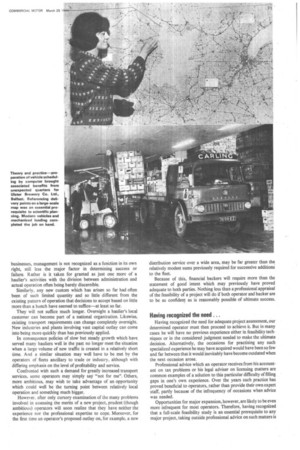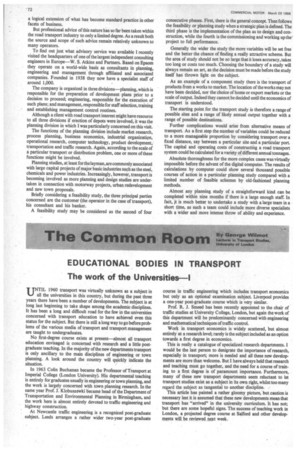Assessing Major Projects
Page 72

Page 73

Page 74

If you've noticed an error in this article please click here to report it so we can fix it.
TONG hours of diligent attention to customers' requirements La have been a common road to success in haulage. By the same token it has often been a slow, laborious road. For this and other reasons road transport is an industry in which small operational units predominate-93 per cent of all hauliers have no more than 10 vehicles.
By traditional standards such a rate of progress could be considered sound practice. But too assiduous adherence to the precept of learning to walk first could obscure the fact that doing just that was taking far too long.
Because road transport is a service industry there are many factors outside an operator's control which could restrain, if not wholly restrict, the rate of growth. The economic viability of the geographical area in which an operator sets up in business would seem an obvious example. But such a contention would be valid only in the limited context of local tradition. Indeed the more current success was dependent upon a haulier's local knowledge of his customer's trade, the more there could be a conditioned acceptance of a limitation on the size of his fleet.
In some instances this conditioned acceptance may have arisen almost unconsciously, along with the slow rate of growth which so often applies in such cases. Alternatively the haulier may have deliberately preferred a modest level of achievement coupled with a limitation of responsibilities and rewards which normally would follow from such a decision.
But what of the haulier who realizes the restraint which his present mode of operation places on further expansion on an appreciable scale, but who is not satisfied with his present level of achievement?
He may appreciate that much of his success to date is dependent on local expertise. He will then, by the same token, be forewarned as to his lack of knowledge of operation on a national or even international scale. Likewise the more he knows every facet and potentiality of local industry, the more likely it is that he knows little of the transport requirements of expanding industries elsewhere.
Yet despite all these possible pitfalls to expansion, including difficulties arising from licensing and financing, a haulier may still be determined to expand his activities beyond the boundaries dictated so far by local conditions and other associated factors. If so, how does he best set about it?
At the outset it could be rightly claimed that such a set of circumstances is by no means new in road transport. Several small hauliers of the past have taken the plunge and got away with it to become the successful operators of large fleets. How many others failed or were only partially successful before cutting their losses and selling out at a buyer's price goes unrecorded because outright bankruptcies comprise only a small proportion of this less fortunate group.
Unfortunate lack of information
Lack of such information is unfortunate. Much could have been learnt as to the cause of failure or partial failure. But two causes would seem to predominate: Inadequate prior assessment of the feasibility of an expansion project is one. The other is inadequate management organization to cope with all the problems of big fleet operation once the project is under way.
Too often it has been overlooked that enlarging a fleet to a required strength—even when protracted delivery dates apply— is a shorter and simpler task than rapidly increasing both the number and competence of management staff.
These two causes are inter-related. Inadequate prior assessment will include failure to take a cool look at future management requirements. Indeed, in many existing small haulage businesses, management is not recognized as a function in its own right, still less the major factor in determining success or failure. Rather is it taken for granted as just one more of a haulier's activities with the division between administration and actual operation often being barely discernible.
Similarly, any new custom which has arisen so far had often been of such limited quantity and so little different from the existing pattern of operation that decisions to accept based on little more than a hunch have seemed to suffice—at least so far.
They will not suffice much longer. Overnight a haulier's local customer can become part of a national organization. Likewise, existing transport requirements can change completely overnight. New industries and plants involving vast capital outlay can come into being more quickly than has previously applied.
In consequence policies of slow but steady growth which have served many hauliers well in the past no longer meet the situation when a large volume of new traffic is created in a relatively short time. And a similar situation may well have to be met by the operators of fleets ancillary to trade or industry, although with differing emphasis on the level of profitability and service.
Confronted with such a demand for greatly increased transport services, some operators may simply say "not for me", Others, more ambitious, may wish to take advantage of an opportunity which could well be the turning point between relatively local operation and something much bigger.
However, after only cursory examination of the many problems involved in assessing the merits of a new project, prudent (though ambitious) operators will soon realize that they have neither the experience nor the professional expertise to cope. Moreover, for the first time an operator's proposed outlay on, for example, a new distribution service over a wide area, may be far greater than the relatively modest sums previously required for successive additions to the fleet.
Because of this, financial backers will require more than the statement of good intent which may previously have proved adequate to both parties. Nothing less than a professional appraisal of the feasibility of a project will do if both operator and backer are to be as confident as is reasonably possible of ultimate success.
Having recognized the need . . .
Having recognized the need for adequate project assessment, our determined operator must then proceed to achieve it. But in many cases he will have no previous experience either in feasibility techniques or in the considered judgment needed to make the ultimate decision. Alternatively, the occasions for practising any such specialized experience he may have acquired would have been so few and far between that it would inevitably have become outdated when the next occasion arose.
Professional advice which an operator receives from his accountant on tax problems or his legal adviser on licensing matters are common examples of a solution to this particular difficulty of filling gaps in one's own experience. Over the years such practice has proved beneficial to operators, rather than provide their own expert staff, partly because of the infrequency of occasions when advice was needed.
Opportunities for major expansion, however, are likely to be even more infrequent for most operators. Therefore, having recognized that a full-scale feasibility study is an essential prerequisite to any major project, taking outside professional advice on such matters is a logical extension of what has become standard practice in other facets of business.
But professional advice of this nature has so far been taken within the road transport industry to only a limited degree. As a result both the source and scope of such advice remain relatively unknown to many operators.
To find out just what advisory service was available I recently visited the headquarters of one of the largest independent consulting engineers in Europe—W. S. Atkins and Partners. Based on Epsom they operate on a world-wide basis as consultants in planning, engineering and management through affiliated and associated companies. Founded in 1938 they now have a specialist staff of around 1,000.
The company is organized in three divisions—planning, which is responsible for the preparation of development plans prior to a decision to proceed; engineering, responsible for the execution of such plans; and management, responsible for staff selection, training and establishing management control routines.
Although a client with road transport interest might have resource to all three divisions if erection of depots were involved, it was the planning division in which I was particularly concerned on this visit.
The functions of the planning division include market research, process planning, business economics, industrial organization, operational research, computer technology, product development, transportation and traffic research. Again, according to the scale of a particular transport or distribution problem, one or more of these functions might be involved.
Planning studies, at least for the layman, are commonly associated with large capital projects of major basic industries such as the steel, chemicals and power industries. Increasingly, however, transport is becoming involved as more planning and design studies are undertaken in connection with motorway projects, urban redevelopment and new town proposals.
Briefly considering a feasibility study, the three principal parties concerned are the customer (the operator in the case of transport), his consultant and his banker.
A feasibility study may be considered as the second of four consecutive phases. First, there is the general concept. Then follows the feasibility or planning study when a strategic plan is defined. The third phase is the implementation of the plan as to design and construction, while the fourth is the commissioning and working up the project to full performance.
Generally the wider the study the more variables will be set free and the better the chance of finding a really attractive scheme. But the area of study should not be so large that it loses accuracy, takes too long or costs too much. Choosing the boundary of a study will always remain an art, as the decision must be made before the study itself has thrown light on the subject.
As an example of a component study there is the transport of products from a works to market. The location of the works may not have been decided, nor the choice of home or export markets or the scale of output. Indeed they cannot be decided until the economics of transport is understood.
The starting point for the transport study is therefore a range of possible sites and a range of likely annual output together with a range of possible destinations.
Further complications would arise from alternative means of transport. As a first step the number of variables could be reduced to a more manageable proportion by considering transport over a fixed distance, say between a particular site and a particular port. The capital and operating costs of constructing a road transport system could be calculated for a variety of different annual tonnages.
Absolute thoroughness for the more complex cases was virtually impossible before the advent of the digital computer. The results of calculations by computer could show several thousand possible courses of action in a particular planning study compared with a limited number of feasible schemes by old-fashioned planning methods.
Almost any planning study of a straightforward kind can be completed within nine months if there is a large enough staff. In fact, A is much better to undertake a study with a large team in a short time, as such a team could include more diverse specialists with a wider and more intense throw of ability and experience.




















































































































